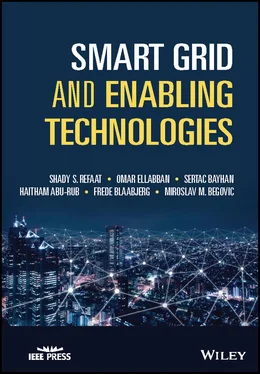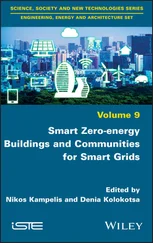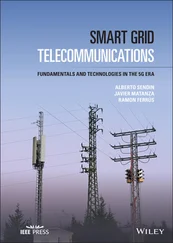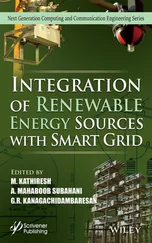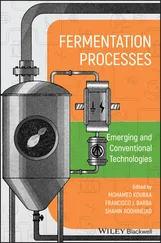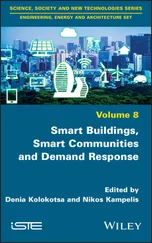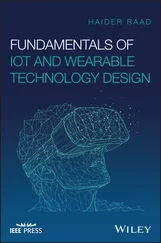Frede Blaabjerg - Smart Grid and Enabling Technologies
Здесь есть возможность читать онлайн «Frede Blaabjerg - Smart Grid and Enabling Technologies» — ознакомительный отрывок электронной книги совершенно бесплатно, а после прочтения отрывка купить полную версию. В некоторых случаях можно слушать аудио, скачать через торрент в формате fb2 и присутствует краткое содержание. Жанр: unrecognised, на английском языке. Описание произведения, (предисловие) а так же отзывы посетителей доступны на портале библиотеки ЛибКат.
- Название:Smart Grid and Enabling Technologies
- Автор:
- Жанр:
- Год:неизвестен
- ISBN:нет данных
- Рейтинг книги:3 / 5. Голосов: 1
-
Избранное:Добавить в избранное
- Отзывы:
-
Ваша оценка:
- 60
- 1
- 2
- 3
- 4
- 5
Smart Grid and Enabling Technologies: краткое содержание, описание и аннотация
Предлагаем к чтению аннотацию, описание, краткое содержание или предисловие (зависит от того, что написал сам автор книги «Smart Grid and Enabling Technologies»). Если вы не нашли необходимую информацию о книге — напишите в комментариях, мы постараемся отыскать её.
Smart Grid and Enabling Technologies
Smart Grid and Enabling Technologies
Smart Grid and Enabling Technologies — читать онлайн ознакомительный отрывок
Ниже представлен текст книги, разбитый по страницам. Система сохранения места последней прочитанной страницы, позволяет с удобством читать онлайн бесплатно книгу «Smart Grid and Enabling Technologies», без необходимости каждый раз заново искать на чём Вы остановились. Поставьте закладку, и сможете в любой момент перейти на страницу, на которой закончили чтение.
Интервал:
Закладка:
1.5.4 Integrated Communications
Communication infrastructure is essential for the effective functioning of SGs. The implementation of communication technologies guarantees the decrease of energy consumption, ensures best implementation of the SG, and provides coordination among all SGs' components from generation to the end‐users. Examples of existing communication network technologies used for SG are fiber optics, WLAN, cellular communication, WiMAX, and power pine communication (PLC). Detailed discussion of the integrated communication in the SG and a comparison of communication infrastructure between the legacy grid and the SG communication standards and research challenges and future trends are presented in Chapter 8.
1.5.4.1 Communication Networks
The communication system connects various components of SG architecture for real‐time control, monitoring, and data utilization. Integrated communication is the connector for all SG technologies. The communication infrastructure of the SG is predicated upon three types of networks: Home Area Network (HAN), Neighborhood Area Network (NAN), and Wide Area Network (WAN). Figure 1.10shows the diagram of the SG communication infrastructure [28]. HANis installed and operated in a small area (tens of meters) and has a lower transmission data rate of hundreds of bits per second. HAN consists of a broadband internet connection used to communicate and share the data between devices over a network connection and smart meters. HAN offers more efficient home energy management [28]. NANis installed and operated in an area over hundreds of meters. A number of HANs can be connected to one NAN to transmit the data of other NAN networks and to local data centers for storage and further analytics. The NAN has a 2 Kbps transmission data rate. Different technologies can be used to implement the NAN network such as PLC, Wi‐Fi, and Cellular [29].
WANis installed and operated in an area of tens of kilometers and it contains several NANs and LDCs. The communication between SG components such as renewable energy generation, transmission, distribution, and the operator control center are predicated upon a WAN network [30]. SG communication infrastructures share the same main challenge, which is how to be merged effectively. A number of technologies can be employed to the SG to achieve an effective merge between communication infrastructure. These technologies are ZigBee, WLAN, Cellular networks, and Power Line Communication (PLC).
ZigBeeis utilized in applications requiring a small data rate, prolonged battery life, low price, and safe networking. Applications also include wireless light switches, traffic control systems, meters for in‐home‐displays, and extra consumer and industrial devices that require a short‐range of wireless data transmission at relatively low rates. The benefits of ZigBee application in the SG are low cost, decreased size, and relatively decreased bandwidth. The drawbacks of the ZigBee are the small battery which suggests a short lifetime, small memory, limited data rate, and low processing capability [31].
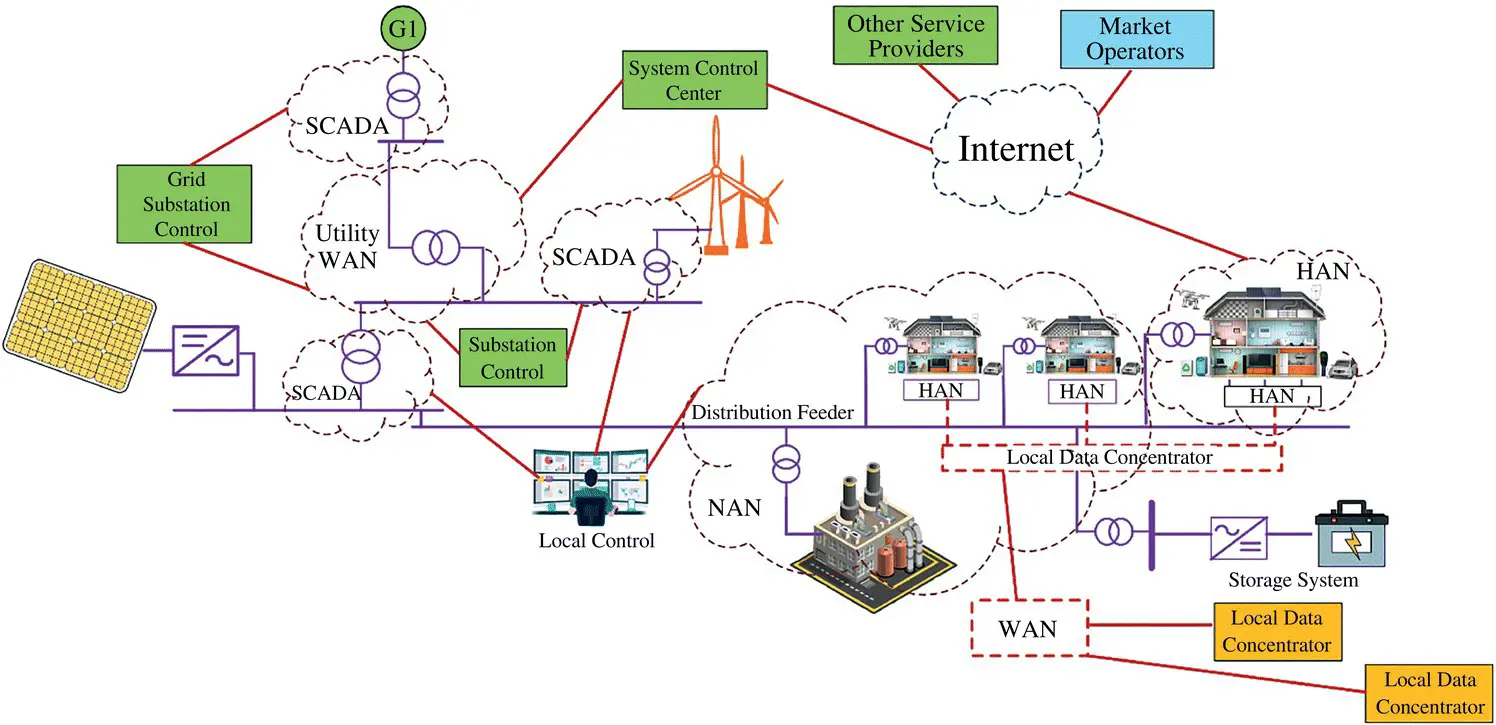
Figure 1.10 Schematic diagram communication infrastructure for the SG.
WLAN isa wireless local area network (WLAN) that links two or more devices through the use of spread‐spectrum or Orthogonal Frequency Division Multiplexing (OFDM) [32] and generally delivering a connection through an access point to the internet. This provides customers with the chance to roam around in a local coverage area and at the same time maintain connection with the network. The benefits of WLAN are low price, huge installations worldwide, and plug and play (PnP) devices. The main drawback of WLAN is possible interferences with other devices that communicate on similar frequencies.
Cellular networksare vastly employed in the majority of countries and possess a well‐recognized infrastructure. Cellular networks could be utilized for communication among a number of components and devices in the SG. There are a number of current technologies for cellular communication including GSM, GPRS, 3G, 4G, 5G, and WiMAX [33]. The benefits of the cellular networks are presently available infrastructure across a vast area of implementation, elevated rates of data transmission, existing security systems implemented in cellular communication. The main drawback is that cellular networks are shared with other customers and are not fully devoted to SG communications.
1.5.4.2 Power Line Communication (PLC)
PLC permits data exchange among devices by electrical power lines. PLC is employed by including a modulated carrier signal to power cables. The benefit of the PLC is the currently recognized infrastructure that decreases deployment costs. Drawbacks include the existence of higher harmonics in the power lines that interfere with communication signals and the limited frequency of communication. Installing a number of smart meters and communication infrastructure should be implemented according to certain standards that are acknowledged by all companies and utilities taking part in building the SG. Different organizations are working on SG standardization such as the European Committee for Standardization, American National Standards Institute (ANSI), International Telecommunication Union (ITU), Institute of Electrical and Electronics Engineers (IEEE), and others. The well‐known standards for SG communications are IEEE P2030, which provides guidelines for interoperability of the electric power system with end‐use applications and loads; IEEE P1901 used by all classes of Broadband over Power Line (BPL) devices, entailing devices utilized for the connection to internet access services and devices utilized in buildings for LANs, smart energy applications, transportation platforms (vehicle), and other data distribution applications; IEC62351, which deals with cybersecurity issues of the SG; IEC62056 for electricity metering data exchange; PLC G3 to allow data and control messages to be transferred to generation, transmission, and distribution systems. There are more standards for SG communication including 802.15.4, ISO 1802, IPv4, DNP3, IEC61970, etc. [34]. More details on the standardization will be discussed in Chapter 17.
1.5.5 Customer Engagement
In the traditional grid, consumers have a passive role while occupying a marginal position in the energy market. Customer engagement has been negligible in the aspect of energy monitoring, controlling, management, generation, storing, and trading. However, with the introduction of the SG paradigm, the consumers have a crucial and active role in all aspects above. The SG technologies open the opportunity for active engagement through real‐time insight in their energy consumption patterns, price changes, local renewable energy production, storing, and energy sharing. Customers engagement is the language of energy DSM in the SG which is used to achieve supply–demand balancing, load shifting, and increased reliability, high efficiency, and resiliency in the electric system. Electric utilities are putting more focus on energy demand management to realize three main tasks: enhancing energy efficiency, direct load control, and to meet a dynamic DR [35].
Energy management on the demand‐side acts on the consumers for controlling electrical energy usage. There are a number of solutions to attain demand management and flexible energy consumption. Direct load control and dynamic DR programs are addressing the biggest priorities and challenges for the successful implementation of demand management in SGs. The participant customers can rely on their generation sources to meet their demand (typical usage requirements) whenever possible. Customer engagement, through (DSM) market prices change, increases with time. Figure 1.11shows the global market of customer engagement. The global energy management systems (EMS) (industrial, home, and building) market size was USD 9.8 billion in 2017 and is expected to increase to USD 72.73 billion in 2024 [36, 37]. The right‐side column of the Figure 1.11indicates the spending per region. The EMS is becoming a crucial tool for both the utility and the customer to monitor, analyze, shift, optimize, and control energy and assets in real‐time.
Читать дальшеИнтервал:
Закладка:
Похожие книги на «Smart Grid and Enabling Technologies»
Представляем Вашему вниманию похожие книги на «Smart Grid and Enabling Technologies» списком для выбора. Мы отобрали схожую по названию и смыслу литературу в надежде предоставить читателям больше вариантов отыскать новые, интересные, ещё непрочитанные произведения.
Обсуждение, отзывы о книге «Smart Grid and Enabling Technologies» и просто собственные мнения читателей. Оставьте ваши комментарии, напишите, что Вы думаете о произведении, его смысле или главных героях. Укажите что конкретно понравилось, а что нет, и почему Вы так считаете.
